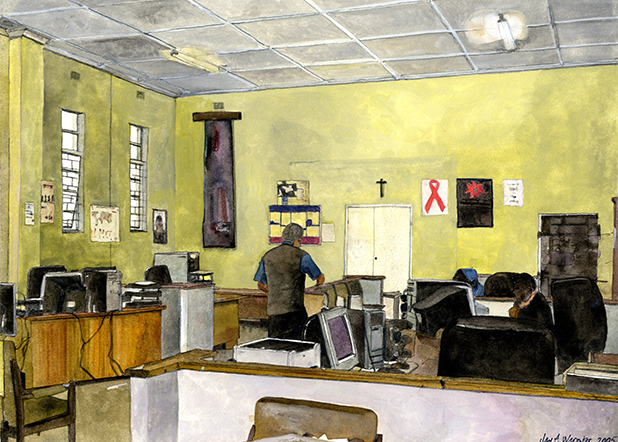 Exterior View (2005), 15” x 11” Watercolor, Jay A. Waronker
Exterior View (2005), 15” x 11” Watercolor, Jay A. Waronker
ZAMBIA
Former Ndola Hebrew Congregation (Founded in 1923) Synagogue (Completed in 1946) |
|

Interior View (2005), 15” x 11” Watercolor, Jay A. Waronker
|
According to congregational records, by 1923 enough Jews lived in Ndola in the central Copperbelt Region of Zambia (formerly North Rhodesia) to form a minyan (quorum) for prayer services for the first time. During this early period, these services were conducted in private homes or temporary facilities. By 1930, the congregation had acquired a Sefer Torah. It was during the years immediately leading up to World War II and during the war years themselves that Jewish refugees arrived in Ndola and other Zambian cities, and this provided the stimulus for the creation of more tangible religious institutions and activities. At this time, the synagogue at Ndola was constructed not in the center of town but on its outskirts.
During the 1950s and 60s, the congregation was at its prime, but by the 1970s the community stagnated before declining precipitously into the 1980s. During this period, after years of British colonial rule, Zambia became an independent nation. This was concurrent with the nationalization followed by the decline of the Zambia’s once-flourishing copper mining industry. The Ndola synagogue in the 1990s was the last to be sold in the Copperbelt Region – in this case to the Ndola Catholic Church. In 1994, its Sefer Torah was sent to Israel by the Council for Zambia Jewry for distribution to new congregations in that country. Today the former synagogue is used as the Catholic Church’s office space since the church has been considerably expanded over the years, including a large sanctuary space elsewhere on the property.
The building, a particularly modest structure, was most likely designed by a local white architect who had no experience in synagogue design or even important civic and ceremonial public architecture. What was realized was an unassuming building finished in gray stucco and some brick. Along its front façade was originally the building’s front doors into the sanctuary. Once the building had been sold to the Catholic Church, these doors were sealed. The building features parapets walls with a corrugated metal roof behind, stretches of corrugated metal roofs engaged in the walls and wrapping about the building like canopies, and various small windows. A Magen David (Star of David) original to the building has never been removed, although it has been painted over. Nevertheless, it can today still be easily recognized. Without this overt Jewish mark, it would be most difficult to identify this utilitarian building as a former synagogue.
What was once the synagogue sanctuary has for years been used as open office space lined with desks for support staff of the Ndola Catholic Church. At the time of this painting, it featured painted yellow plaster walls, narrow awning windows, a flat ceiling of painted panels with their joints covered by batten strips, and a former ark that was recessed in the walls with flush doors. Today the former ark appears as an ordinary-looking storage cabinet, yet if one looks carefully it is possible to make out an impression on the wall where the engaged ark surround of some sort was once located.
During the artist’s visit to the site, he and his chaperone, local Jew Gus Liebowitz, were initially welcomed and invited into the church spaces, but in time others there became less hospitable and open to their visit. Despite attempts to explain why they had come and their friendly intent, Waronker and Liebowitz realized it was better for them to leave before completing their tour and intended work to document the former synagogue.
